Corsair Force LS (240GB) Review
by Kristian Vättö on September 25, 2013 12:00 AM ESTAnandTech Storage Bench 2011
Two years ago we introduced our AnandTech Storage Bench, a suite of benchmarks that took traces of real OS/application usage and played them back in a repeatable manner. Anand assembled the traces out of frustration with the majority of what we have today in terms of SSD benchmarks.
Although the AnandTech Storage Bench tests did a good job of characterizing SSD performance, they weren't stressful enough. All of the tests performed less than 10GB of reads/writes and typically involved only 4GB of writes specifically. That's not even enough exceed the spare area on most SSDs. Most canned SSD benchmarks don't even come close to writing a single gigabyte of data, but that doesn't mean that simply writing 4GB is acceptable.
Originally we kept the benchmarks short enough that they wouldn't be a burden to run (~30 minutes) but long enough that they were representative of what a power user might do with their system. Later, however, we created what we refer to as the Mother of All SSD Benchmarks (MOASB). Rather than only writing 4GB of data to the drive, this benchmark writes 106.32GB. This represents the load you'd put on a drive after nearly two weeks of constant usage. And it takes a long time to run.
1) The MOASB, officially called AnandTech Storage Bench 2011—Heavy Workload, mainly focuses on the times when your I/O activity is the highest. There is a lot of downloading and application installing that happens during the course of this test. Our thinking was that it's during application installs, file copies, downloading, and multitasking with all of this that you can really notice performance differences between drives.
2) We tried to cover as many bases as possible with the software incorporated into this test. There's a lot of photo editing in Photoshop, HTML editing in Dreamweaver, web browsing, game playing/level loading (Starcraft II and WoW are both a part of the test), as well as general use stuff (application installing, virus scanning). We included a large amount of email downloading, document creation, and editing as well. To top it all off we even use Visual Studio 2008 to build Chromium during the test.
The test has 2,168,893 read operations and 1,783,447 write operations. The IO breakdown is as follows:
| AnandTech Storage Bench 2011—Heavy Workload IO Breakdown | ||||
| IO Size | % of Total | |||
| 4KB | 28% | |||
| 16KB | 10% | |||
| 32KB | 10% | |||
| 64KB | 4% | |||
Only 42% of all operations are sequential; the rest ranges from pseudo to fully random (with most falling in the pseudo-random category). Average queue depth is 4.625 IOs, with 59% of operations taking place in an IO queue of 1.
Many of you have asked for a better way to really characterize performance. Simply looking at IOPS doesn't really say much. As a result we're going to be presenting Storage Bench 2011 data in a slightly different way. We'll have performance represented as Average MB/s, with higher numbers being better. At the same time we'll be reporting how long the SSD was busy while running this test. These disk busy graphs will show you exactly how much time was shaved off by using a faster drive vs. a slower one during the course of this test. Finally, we will also break out performance into reads, writes, and combined. The reason we do this is to help balance out the fact that this test is unusually write intensive, which can often hide the benefits of a drive with good read performance.
There's also a new light workload for 2011. This is a far more reasonable, typical every day use case benchmark. It has lots of web browsing, photo editing (but with a greater focus on photo consumption), video playback, as well as some application installs and gaming. This test isn't nearly as write intensive as the MOASB but it's still multiple times more write intensive than what we were running last year.
We don't believe that these two benchmarks alone are enough to characterize the performance of a drive, but hopefully along with the rest of our tests they will help provide a better idea. The testbed for Storage Bench 2011 has changed as well. We're now using a Sandy Bridge platform with full 6Gbps support for these tests.
AnandTech Storage Bench 2011—Heavy Workload
We'll start out by looking at average data rate throughout our heavy workload test. The Corsair Force LS (and Phison) tend to be in the bottom third of the graphs, but overall performance is still reasonable for a budget drive.
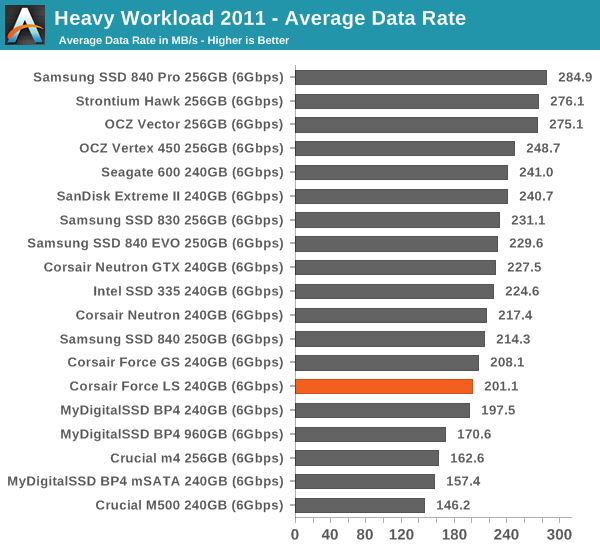
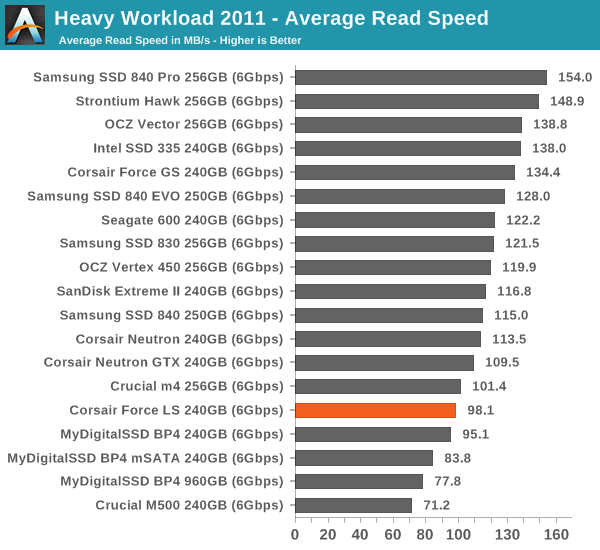
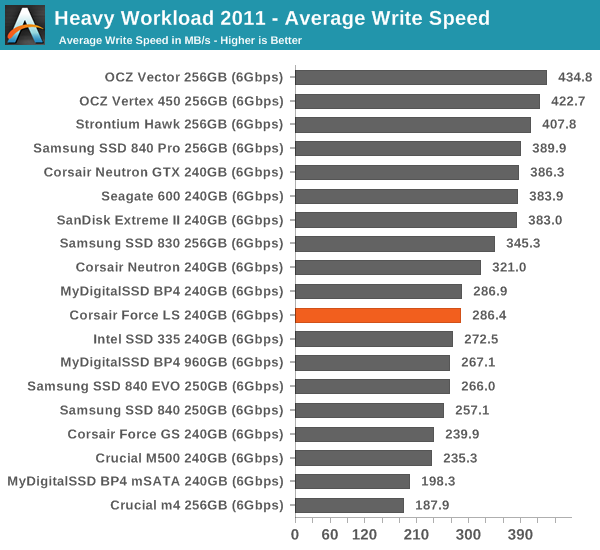
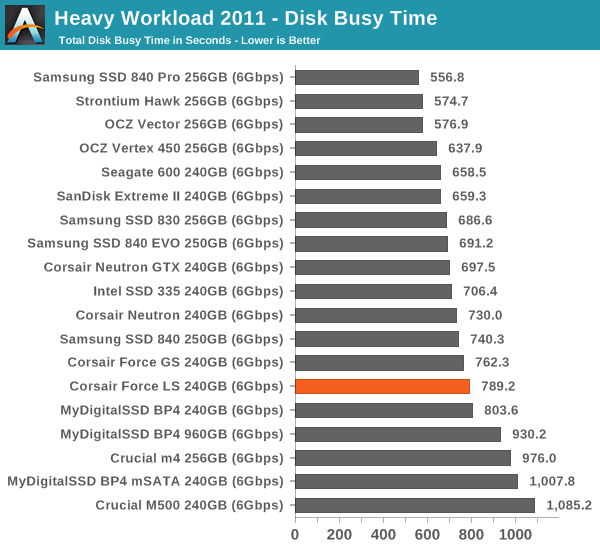
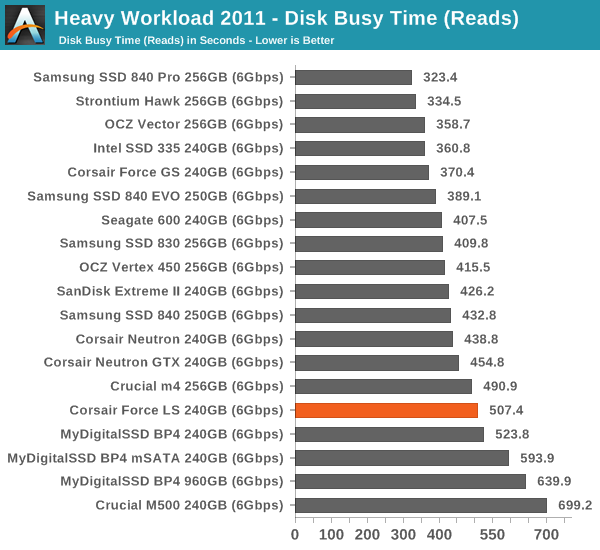
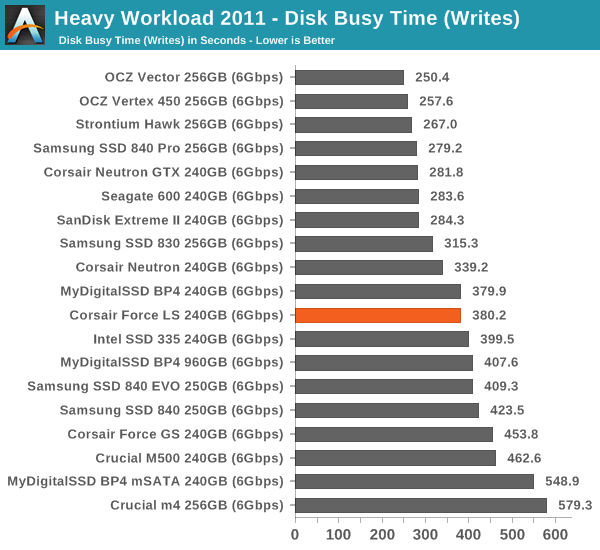










25 Comments
View All Comments
Runamok81 - Wednesday, September 25, 2013 - link
Looks like we have a shrinking middle-class withh SSDs as well. Does this mean manufactuers should focus on one extreme of the performance/value slider or else risk consumers purchasing leftover stock from last years tech?MrSpadge - Wednesday, September 25, 2013 - link
The problem with budget and middle class SSDs is that the bulk of the cost goes into the flash - which you have to buy anyway. The controller does cost a bit, but you can't save much by making an SSD slower. That's why it's not really worth it for customers to spend a little less for a significantly slower SSD. Exception: Samsung 840/840 Evo. they've still got the excellent controller and at least decent performance, yet they mostly cost significantly less than others.ericbentley - Monday, September 30, 2013 - link
Samsung 840/840 Evo can afford to use a good controller yet still be budget oriented because they use TLC flash, while the Corsair LS here still uses MLC. While MLC is better in terms of longevity, most people still want the benefits of speed from the controller and MLC vs TLC is a back-burner issue for themI'm wondering if Corsair had tried TLC before and had some reason for not using it for a drive like this, seems like a no brainer to me, unless they couldn't secure a large enough supply
Kristian Vättö - Wednesday, September 25, 2013 - link
I think we are starting to get to a similar point as where DRAM is now. For an average user, the difference between a low-end and high-end SSDs is becoming negligible because even the low-end SSDs are pretty good now (e.g. the Force LS). That means the middle-class no longer serves a purpose because the average users will mostly go with the cheaper options and enthusiasts only want the fastest.vol7ron - Wednesday, September 25, 2013 - link
The big thing still out there, that hasn't been answered is lots of flash for cheap. When buying an SSD many customers look for the fastest, since the cost is marginal between what's available. However, the one area of the market that is still "expensive" is in the mass-flash +1TB (or even +512GB). Even with a slower controller/NAND, I think Corsair could slide into this space. Look at Apple and what they're shipping their new Mac with - what's it called? Fusion? - essentially a hybrid drive, rebranded. I'm sure a company that focuses on the best balance of quality vs cost, wouldn't do that if SSD costs were lower. --- There's still the niche market for high capacity flash, the ultimate HDD terminator.Spoony - Sunday, September 29, 2013 - link
Apple is shipping a 128GB SSD alongside a normal platter drive in 1TB or 2TB configurations. Fusion Drive is just the name for a logical volume manager with block migration. They are not re-branding a hybrid drive like a Momentus XT. It is a custom solution which merges two discrete devices in software. For better or worse.I definitely agree with you. 1-2TB SSDs at $0.40/MB rather than the current $0.95/MB would be very compelling. I would buy if it was reliable, even if it wasn't blazing fast.
Spoony - Sunday, September 29, 2013 - link
1TB or 3TB configs. Not 2TB. Sorry.Also, edit functionality would be convenient.
Cumulus7 - Wednesday, September 25, 2013 - link
Since you recommend the Samsung EVO over the Crucial M500: aren't yout concerned that the EVO may not last as long as the M500?I prefer the M500 at the moment since i expect its NAND to last a lot longer. But i may be wrong...
fokka - Wednesday, September 25, 2013 - link
of course mlc should theoretically last longer, but that doesn't mean tlc doesn't last more than long enough, as you can read here:http://www.anandtech.com/show/7173/samsung-ssd-840...
MrSpadge - Wednesday, September 25, 2013 - link
I'd choose and recommend the Evo as well, for all typical users. People write much less on average than they fear they might. It's only a different story for power users, servers etc.